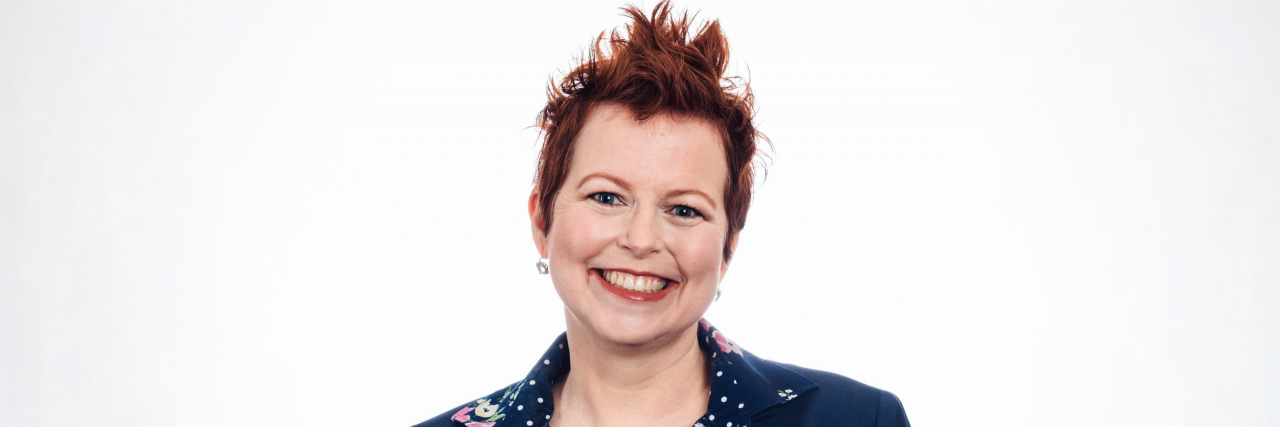‘Finding My Voice Helped Me Find My Power’— A Woman’s Journey With HAE
When Kemmi was little, every holiday gathering led to her being sick all night, experiencing painful swelling in her abdomen. Since these holidays were centered around meals, her family often assumed she over-indulged, labeling her as an overly sensitive kid. “Oh, Kemmi’s complaining again,” they would say.
Over time, she learned to internalize her pain – both the physical experience of swells and the emotions of feeling different from those around her. “I felt defective and without a voice,” said Kemmi. “I became used to the idea of other people telling me I was wrong, and that my symptoms were all in my head.”
Despite these challenges, she continued to live the best life she could. For a time, she worked as an actor, a job she loved. “I once told my daughter that acting was the best experience of my life because it allowed me to find my voice and express a range of emotions: yelling, crying, being tough, being funny—I had never felt so alive. I realized that it was out in the real world where I had been acting all along, pretending nothing was wrong.”
After decades of attacks, Kemmi could no longer keep up the act. Her swelling symptoms spread to other parts of her body, and she began to experience laryngeal attacks that caused her tongue to swell, making it difficult to breathe.
Desperate for answers, Kemmi eventually came across the term “hereditary angioedema (HAE).” She connected with an advocate from the Hereditary Angioedema Association (HAEA) who verified, “this is not in your head, and you are not alone.”
Finding a preventive treatment
For people living with HAE like Kemmi, attacks can cause parts of the body, including the abdomen, face, feet, genitals, hands, and throat, to swell up. Not only can these attacks be overwhelming, but when they impact the throat, they can also be life-threatening. Without treatment, people can experience two to four attacks a month, lasting for three to five days.
The hereditary nature of the condition meant that discovering the truth about her symptoms was a relief for not only Kemmi, but also for her daughter, who had started experiencing attacks in adulthood, although each of their symptoms presented differently. The two women engaged with their doctors to find a path forward. “The diagnosis made me feel more like a partner in my health care, rather than just a patient,” Kemmi explains.
To help manage the frequency of HAE attacks, Kemmi’s doctor prescribed her TAKHZYRO (lanadelumab-flyo), a medicine used to prevent attacks of HAE in people 2 years of age and older. It is not known if TAKHZYRO is safe and effective in children under 2 years of age. Kemmi and her doctor discussed the potential risks such as serious side effects including allergic reactions, as well as more common risks including injection site reactions, upper respiratory infections and headaches. Her doctor also explained that in a clinical study, people taking TAKHZYRO 300 mg every 2 weeks experienced 87% fewer attacks and 83% fewer moderate or severe attacks on average compared with placebo (average monthly attack rate of 0.3 vs 2.0).
Kemmi’s daughter, having navigated her own path with the condition, found hope in this treatment option as well. Patients who have been diagnosed with HAE and are experiencing attacks should talk to their doctor to see if TAKHZYRO could be right for them. For more details, see the Important Safety Information below.
“I was excited about the subcutaneous administration method because I have experienced vein access issues. My immunologist said that patients who were prescribed TAKHZYRO had fewer attacks, and the attacks they did have were less severe. Those were the motivating factors for me to choose TAKHZYRO as my preventive medication.”
Finding her voice to advocate for her health
Since starting TAKHZYRO, Kemmi began to experience fewer swells, and the swells she has are less severe. Today, she hopes to encourage others who may be experiencing unexplained symptoms to speak with their doctor to find the help they need.
“While searching for answers about my HAE, I learned how to advocate for my health and set an example for my daughters and my granddaughter, the absolute loves of my life,” she shares. “Finding my voice helped me find my power. By insisting to doctors that something was wrong, I was able to find a treatment that worked for me.”
Kemmi is a paid ambassador for Takeda.
What is TAKHZYRO?
TAKHZYRO (lanadelumab-flyo) is a prescription medicine used to prevent attacks of hereditary angioedema (HAE) in people 2 years of age and older.
It is not known if TAKHZYRO is safe and effective in children under 2 years of age.
IMPORTANT SAFETY INFORMATION
TAKHZYRO may cause serious side effects, including allergic reactions. Call your healthcare provider or get emergency help right away if you have any of the following symptoms:
- wheezing
- difficulty breathing
- chest tightness
- fast heartbeat
- faintness
- rash
- hives
The most common side effects seen with TAKHZYRO were injection site reactions (pain, redness, and bruising), upper respiratory infection, headache, rash, dizziness, diarrhea, and muscle aches.
These are not all the possible side effects of TAKHZYRO. For more information, ask your healthcare provider or pharmacist. You may report side effects to FDA at 1-800-FDA-1088.
TAKHZYRO has not been studied in pregnant or breastfeeding women. Talk to your healthcare provider about the risk of taking TAKHZYRO if you are pregnant, plan to be pregnant, are breastfeeding, or plan to breastfeed.
Please see full Prescribing Information, including information for patients.
To learn more about HAE and TAKHZYRO visit https://www.takhzyro.com or speak with your doctor.
©2025 Takeda Pharmaceuticals U.S.A., Inc., 500 Kendall Street, Cambridge, MA 02142. 1-877-TAKEDA-7 (1-877-825-3327). All rights reserved. TAKEDA and the TAKEDA Logo are registered trademarks or registered trademarks of Takeda Pharmaceutical Company Limited. TAKHZYRO® is a registered trademark of Dyax Corp. US-LANA-2300v1.0 09/25


